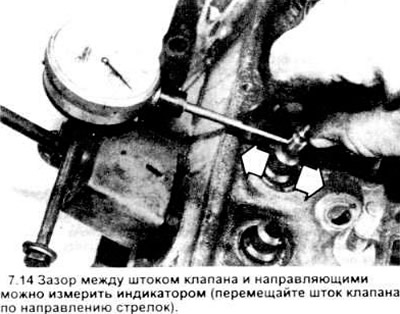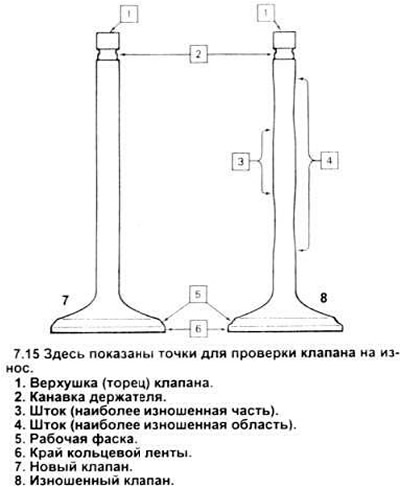Cleaning
2. Scrape off all traces of the old gasket material and seal from the head gasket and sealing surfaces of the intake and exhaust manifolds. Be very careful not to scratch the head.
3. Remove all parts built into the cooling channels.
4. Go through the holes with a stiff wire brush to remove any accumulation of deposits on the walls.
5. Go through the threaded holes with an appropriately sized tap to remove rust and thread seal residue. If possible, remove chips and dirt from machining with compressed air.
6. If necessary, process the threaded connections of the axes of the rocker arms with taps of the appropriate size.
7. Wash the cylinder head with solvent and dry thoroughly.
8. Clean valve levers, pivot pins, bolts and push rods with solvent and dry thoroughly (do not mix them during the cleaning process).
9. Wash the springs of all valves, screens crackers and plates with solvent and dry thoroughly.
10. Clean any deposits that may have formed on the valves, then use a motorized wire brush to clean the deposits from the valve heads and stems. Once again, make sure that you do not mix up parts from different valves.
Examination
Cylinder head
11. Carefully inspect the cylinder head for cracks, obvious coolant leakage, and other damage. If you find cracks, then it will have to be replaced with a new one.
12. Using a straight edge and feeler gauge, check for possible distortion of the surface adjacent to the head gasket (see picture).

If the misalignment exceeds the specification limit, the surface should be machined.
13. In each of the combustion chambers, check the valve seats. If they have pitting, cracks or burnouts, the cylinder head should be replaced.
14. Check the gap between the valve stem and the guide by measuring the transverse displacement of the valve stem with an indicator connected directly to the head (see drawing). The valve must be in the guide and approximately 1.588 mm (1/16 inch) over the saddle. Divide the full stroke of the valve stem, fixed by the indicator leg, by 2 and get the value of the actual clearance.

Valves
15. Carefully inspect the outer surface of the valve for premature wear, deformation, cracks, corrosion spots and burns (see picture). Check the valve stem for metal enveloping and abrasion, and check the neck for cracks. Rotate the valve and check if it is bent. The end of the stem may have pitting and areas of heavy wear. If any of the above is found, then the valves should be replaced.

16. Measure the width of the edge of the annular band of each valve (see picture). The valve should be replaced with a new one if the width of this tape is less than 0.794 mm (1/32 inch).

Valve elements
17. Check all valve springs for wear and pitting. Measure free length and compare to specification (see picture). If the spring is shorter than the required length, then it "villages" and can no longer be used. The compression force of each spring is determined using a special clamp; according to the results of the test, a decision is made whether it is possible to use it in a rebuilt engine.

18. Install each spring end face on a flat surface and check its shape. If any spring is deformed or "villages", replace it with a new one.

19. Visually check up crackers and plates of springs on deterioration and cracks. Replace all questionable parts with new ones, since their failure in a running engine will result in serious damage.
Valve lever elements
20. Check the lever faces (contact surfaces with the ends of the pusher rods and valve stems) for pitting, wear, metal fouling, scratches and scuffs. Also check the rotating part of the contact surface of the lever and the hinge pin. Inspect each lever and bolt for cracks.
21. Check the ends of the push rods for abrasion and heavy wear. Roll each rod on the glass to determine the degree of curvature.
22. Check the valve lever studs in the cylinder heads - thread damage and incorrect installation are possible.
23. Any damaged or heavily worn parts should be replaced with new ones.
25. If intensively worn parts were not found, and the outer surfaces and valve seats are in good condition, then the valve group can be installed in the cylinder heads without any special modifications.
Visitor comments